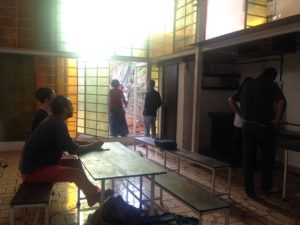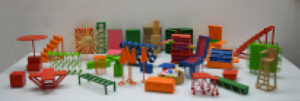By LILIANA GIL, 6/19/2016. In Mumbai, I had the pleasure of meeting Rupali Gupte and Prasad Shetty, two urbanists whose work I think opens up ways of talking about resourcefulness and technological improvisation that don’t fall immediately into the familiar narratives I highlighted here. Having met them through a friend, I got to visit two of their projects: the School of Environment and Architecture in Borivali and the R&R space in Mankhurd. In the first, they run a BA program in Architecture that has a very interesting emphasis on practice – I wish I had taken photos of the drafting tables students make when they enter the program! The second, a play on words that suggests Resettlement-and-Rehabilitation as well as Rest-and-Relaxation, is a yet-to-be-defined space in the heart of a rehabilitated slum. Mostly built with materials from Kurla’s impressive recycling market, it took them less than five weeks and two thousand dollars to put together what is now becoming a community-oriented event space, garden, and library.

Gupte and Shetty’s practice is hybrid. Not only are they artists, educators, and activists, but their work also seems to involve the kind of intimate and detailed knowledge of Mumbai that I would identify as ethnographic. Transactional Objects, showed at Venice Biennale in 2015, illustrates this well.
With careful attention to the everyday strategies of Mumbaites, the collection of nine objects recreates some of the ways in which people make the material city. There is the Astrologer’s Chair, inspired by the tall chairs in which old men rest and get to watch the fate of world. There is the Staircase Shop, in reference to the tiny shops one crawls into. But my favorite is the One Foot Shop, a speculation on the super thin wall-embedded shops that one can see in street markets, shops that by the end of the day are folded into imperceptible reliefs on the wall. These objects may be banal, but they are not irrelevant. It is through them that things get transacted and aspirations are produced and this big city happens.
In “It takes so much for a city to happen” (2015), Gupte and Shetty elaborate on the idea of transactionality. Focused on Lamington Road, Mumbai’s electronic cluster, they give very vivid examples of a transactional practice – pagadi, which allows for property transactions despite the legal deadlock between landlords and tenants – space – the one-foot-shops – and object – the beta phone communication system, that connects all the traders in the area. I quote them at length:
Transactional spaces, practices, and object are unique to particular cities and may appear unusual to an outsider. It is through them that the city settles. Settling is a process through which people come to terms with each other’s lives and their landscapes. It is not a process in which contradictions get resolved; instead, through settling, contradictions are able to coexist. It is a set of elaborate mechanics that keep the city in a perpetual state of becoming. However, the city never settles completely. These spaces, practices, and objects get layered further, or change, or disappear. The logic of this transformation is often incremental, sporadic, and based on parameters that are beyond the detection of empirical methods. This transformation changes the transactional capacities of the spaces/practices/objects. Transactional capacity is that capacity of the space/practice/object that allows the flow of bodies, commodities, ideas, and money through it: the higher the flow, the higher the transactional capacity. Extensions to shops, the folding shops of street vendors, porting devices, resting apparatuses, fixtures fastened to boundary walls that help occupy them, things used to claim space, orphaned furniture left for wanderers—all examples of such transactional spaces/practices/objects. These are not just utilitarian, facilitating transactions. They are also instances of dreams trying to take shape and aspirations trying to get worked out. They are usually quirky, erotic, sedimented, and absurd.

